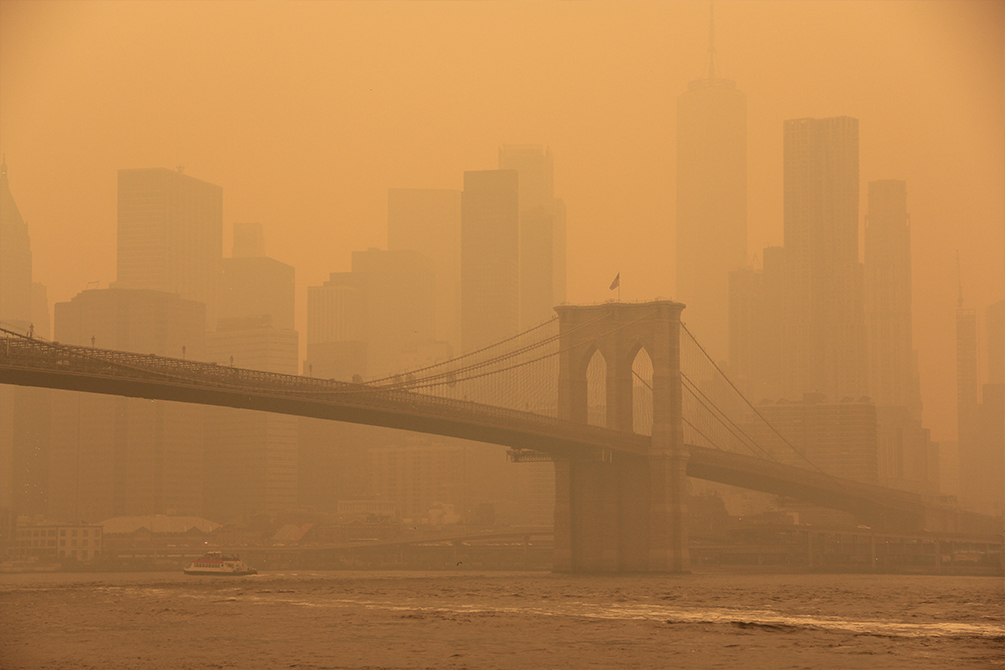Sara Adar’s research informs the EPA and helps safeguard kids

‘Changing the world because of my science’
By Jenni Laidman
Sara Adar jokes that her kids have grown tired of her antics—as she puts it, they are “very much over me.” Although her 14-year-old twins still call her “Science Mom,” they no longer participate when she stops the car at a moment’s notice to go play in traffic, testing some level of environmental disturbance.
Fortunately for the rest of us, Adar is still “playing in traffic.” Maybe not literally, but her focus as an associate professor of Epidemiology at the University of Michigan School of Public Health means many of her more than 85 peer-reviewed papers are based on such roadside attractions as: How bad is air quality inside a home next to an interstate? And are school buses still a significant source of pollution exposure for the kids who ride in them?
Twenty-five million youngsters climb aboard school buses every day in the United States.
A mom helping her new kindergartner mount the steep bus steps may eye the driver warily, relieved that she seems cheerful and reliable. That same mom might worry about who her little one will sit next to. Will they be friends? Will they get along? But mom probably gives little thought to the world she can’t see, even though what comes out of school buses has long been a major source of pollution exposure for children.
Adar, an award-winning researcher from a family of educators, is one mom who thinks about such things. And it’s already made an impact.
Often centerstage in this examination of bus pollution—as well as in discussions about the haze from Canadian wildfires that covered many northern US states this summer—are the infinitesimal particles spewing into the atmosphere during fuel combustion, whether that fuel is diesel or expanses of boreal forests.

The threat such particles pose lies not only in their composition, but in their size. They can be formed of hundreds of chemicals, ranging from carbon soot to metals and even pesticides.
That’s already bad news. But their small size spawns another variety of threat. The smallest of them—it would take a stack of 30 of them to achieve the width of a human hair—can sail into the lungs’ deepest pockets, cruising easily to the bubble-like alveoli where the serious work of the lung takes place.
Each microscopic alveolus is enmeshed in capillaries. When ultrafine particles enter the bubble, they slip across the alveoli’s single-cell wall and into the circulation along with the oxygen that’s supposed to be there.
The more particles we breathe, the more particles that successfully make it past the body’s defense systems and threaten damage wherever they travel. Further, the smallest particles can pass through the olfactory nerves in the nose and go straight to the brain. And as another branch of Adar’s work this year shows, those particles may be shellacked with neurotoxic pesticides.
That tells you something else about the trouble with these fine and ultrafine particles: They can be sticky. Other gunk easily attaches to their surfaces, meaning the stew of toxins they contribute can be both complex and a bit unpredictable.
Adar became intrigued by the riddles environmental pollution posed for human health as an undergraduate at the Massachusetts Institute of Technology while pursuing an environmental engineering degree. Her toxicology class was visited by Anne Anderson, the mom whose child’s leukemia diagnosis led her to discover a cancer cluster among children living near Woburn, Massachusetts.

Anderson’s efforts led to a successful lawsuit and Environmental Protection Agency (EPA) penalties against W.R. Grace, Beatrice Foods and Unifirst for dumping tannery chemicals that seeped into groundwater. The story became the award-winning book, “A Civil Action,” by Jonathan Harr, which was turned into the 1998 film of the same name starring John Travolta.
Anderson’s journey captured Adar’s imagination.
“I thought, wow! That is so interesting and important,” Adar said. “That kind of launched my career in environmental health and epidemiology, and really trying to understand how the world around us impacts our health.”
As she pursued her master’s degree at Johns Hopkins in Baltimore, she began to dive into the questions that intrigued her during an internship at the EPA, participating in a study that looked at home air quality and—you guessed it—traffic.
It turns out particles from different sources have different characteristics. For instance, particles from agricultural emissions are very brain toxic. Why is that? Probably because they’re in an environment where neurotoxins are used to kill insects.”
The results weren’t a big surprise: Air quality in houses closest to freeways had the highest levels of contaminants, while houses farther removed from traffic had lower levels. In this research, she measured contaminants called polycyclic aromatic hydrocarbons, a group of hundreds of chemicals produced by burning coal, crude oil, gasoline, garbage, tobacco and even cooking at high temperatures. These PAHs, as they are known, bind to fine and ultrafine particles or clump together to form particles themselves.
While earning her doctorate at the Harvard T.H. Chan School of Public Health, she ended up back in traffic again, this time driving groups of adults aged 60 or older on long field trips in St. Louis. The results show just how complicated questions of health can be.
Each of the four field trips was designed to expose the group to roadway pollution, with each destination taking one hour to reach. Adar and her team conducted electrocardiograms before and after each two-hour-plus trek, looked at blood samples for markers of inflammation and sampled exhaled air. They also measured pollution levels in the buses.
The results showed the bus riders experienced rising levels of inflammatory markers associated with increasing pollution, especially those with obesity, hypertension or diabetes. It’s long been known that inflammation is the immune system’s response to damage and attack, playing a role in acute injury—a broken bone—and infection.
In more recent decades, research has uncovered a more insidious role. Inflammation promotes the growth of plaque in arteries. It is associated with a heightened risk of heart attack and stroke. It even plays a role in cancer.
Adar, however, said they found a silver lining. Despite these clear signals showing compromised health, the overall health of study participants actually improved. The researchers discovered that socializing during the trip provided another kind of medicine.
“You could see their health was worse on trips with higher pollution, but this subtle pollution effect was being overwritten, in a way, by the big picture,” she said, which may tip us off to how we should deal with our own pollution risks.
If you live in a place with higher levels of pollution—say, Los Angeles—you might be tempted to stay indoors to avoid the contaminants. But Adar suggests you shouldn’t.
“Exercise is almost always going to be better for your health than worrying about your air quality nearby,” she said. “If your neighborhood is only slightly polluted, my suspicion is your health will be substantially better if you go out and exercise every day.”
Many of us in public health came to this field because we wanted to change the world. We wanted to make it a healthier place for people. Even from the get-go, I never wanted to be the kind of scientist who only did things just because I thought they were interesting.”
And, as her research shows, risking normal pollution levels to be among friends is also a good bet.
Yet in the face of an extreme event, like the soot-filled skies caused by wildfires, the calculation changes.
“That would be the one time I’d advise you to skip exercise,” Adar said. “It’s not worth it.”
In dozens of papers, Adar’s work has helped demonstrate that air pollution plays a role in a long list of diseases, from narrowing of the body’s smallest blood vessels, to hardening of the arteries—atherosclerosis—to elevated blood pressure. She’s shown links between various types of pollutants and stroke, cardiovascular risk and emphysema. A large six-city study she co-authored suggested that the one reason Black men have higher rates of hypertension than whites is particulate pollution.
This past summer was a particularly bad one for damaging pollution.
By the end of August, nearly 40,000 wildfires had burned nearly 2 million acres across the US, and in Canada, it’s been even worse, with 58,800 square miles—37 million acres—turned to ash and soot.
Adar’s recent study, this one in August in JAMA Internal Medicine, shows human health effects are greater than we may have realized. The research team looked at a cohort of nearly 28,000 people aged 50 and older to see the association between dementia and long-term particulate pollution. Although every source of particulates except dust is associated with increased dementia, the strongest associations were from particles coming from agriculture and wildfires.
“It turns out particles from different sources have different characteristics,” Adar said. “For instance, particles from agricultural emissions are very brain toxic. Why is that? Probably because they’re in an environment where neurotoxins are used to kill insects.”
That kind of result, Adar said, could have policy implications. The study is part of a collaboration with researchers from 10 different countries, all looking at the impact on different pollution sources on health.
“Many of us in public health came to this field because we wanted to change the world. We wanted to make it a healthier place for people,” Adar said. “Even from the get-go, I never wanted to be the kind of scientist who only did things just because I thought they were interesting. I wanted to be able to see that what I was doing had applications for changing things, for making things better.”
She thinks her school bus research has achieved that goal.

She first looked at school buses and pollution during her postdoctoral stint at the
University of Washington in Seattle, where she eventually led a large study examining
the health impacts on students. Two Seattle school districts replaced older, dirtier
buses, or retrofitted them with pollution control equipment. This was about the time
the US phased in ultra-low sulfur diesel, so the study also uncovered the health benefits
of that change.
Surprisingly, little was known about the impact of school bus pollution on the health of children. Although earlier research had shown high pollution levels inside of school buses, it was unknown how or if that endangered kids. Nor was their data showing the impact of cleaning up bus exhaust.
“This study was the first time anybody had gone in and tested children to figure out if their health was changing,” Adar said.
To document how limiting pollution exposure affected kids, researchers tested about 300 youngsters on about 600 trips on 200 buses over five years. The researchers looked at things such as lung function and exhaled nitric oxide. They also tracked absenteeism and particulate pollution inside and outside the bus.
Several important results emerged: Retrofitting buses and switching to ultra-low-sulfur diesel lowered particle concentrations by as much as 50%. As a consequence, student lung function improved and absenteeism dropped 8%, especially among kids with asthma. The new fuel also meant children had less inflammation in their lungs.
“Sara’s work is a great example of the positive impact that science can have on society,” said Belinda L. Needham, chair of the Department of Epidemiology. “Her research on clean school buses provides compelling evidence to support policy change. By making investments to improve the quality of the air that our children breathe, we can improve both their health and their educational outcomes.”
More recently, Adar and her former doctoral student Meredith Pedde looked at the impact of an EPA program that helped districts replace bus fleets with cleaner vehicles between 2012 and 2017. Because the money for bus replacement was distributed randomly, it allowed for a natural experiment, comparing districts that won funding with those that did not.
“Angels were singing and everyone was excited when we realized this,” Adar said. “Without randomization, you would worry that there’s something different about districts that decided to replace buses compared to those that didn’t.”
Sara’s work is a great example of the positive impact that science can have on society. Her research on clean school buses provides compelling evidence to support policy change. By making investments to improve the quality of the air that our children breathe, we can improve both their health and their educational outcomes.”
— Belinda L. Needham
But the EPA’s strategy of randomly selecting who to fund removed the possibility of accidentally comparing wealthy districts populated by health-conscious parents to poor districts that couldn’t afford to replace buses. Under the EPA program, all districts had an equal chance of funding.
The study proved to be eye-opening.
Because of the EPA’s program, more than 350,000 days of increased school attendance occurred nationwide annually, Adar and colleagues reported in a study published this year in Nature Sustainability. And that’s probably an underestimate, since it doesn’t account for the ongoing impact of better buses. Districts that replaced their old buses had more kids in school each day because of reduced absenteeism compared to districts that didn’t replace buses. These benefits were largest for those districts that replaced the oldest buses—those built before 1990.
An average-sized district replacing a bus built before 1990 would see 45 more kids in school every day. Replacing buses built between 1990 and 2000 put 10 more kids in school every day.
The researchers concluded that if every bus manufactured before 2000 was replaced, 1.3 million more days of attendance annually would follow. The study suggests that the reduced absenteeism probably resulted from fewer asthma attacks and reductions in respiratory problems.
It’s a big deal. In the 2015-16 school year, for instance, 8 million children missed more than 15 days of school. Absenteeism is associated with not only lower academic achievement, but, later in life, poverty, health issues and involvement in the criminal justice system, the US Department of Education reported. Thus, keeping kids in school has long-term economic benefits for the nation. Adar and colleagues estimate that for the cost of $27 million bus replacement, the EPA created $350 million in benefits annually due to reduced absenteeism alone.
That I could change the world because of my science because I’m providing evidence that helps the EPA to make informed decisions makes me feel that I can retire happy. I definitely feel that way.”
Other studies have identified further benefits of replacing old buses, Adar said. A study in Washington state found that retrofitting buses to reduce pollution reduced hospitalization rates for bronchitis, asthma and pneumonia in at-risk groups. A study in Georgia found retrofitting school buses for pollution control led to higher scores on physical activity tests and improved standardized testing scores.
For Adar, the school bus studies are particularly meaningful.
“I feel that I’ve contributed something that’s made a difference,” she said.
Her research led to an invitation to present her data to the EPA. In her presentation, she advised that removing the oldest buses—anything manufactured before 2000—would have the greatest impact.
“That I could change the world because of my science because I’m providing evidence that helps the EPA to make informed decisions makes me feel that I can retire happy,” Adar said. “I definitely feel that way.”
- Interested in public health? Learn more here.
- Read the Alumni Spotlight: 'Kris Sarri: Combating climate change with a policy pen.'
- Read how a Toxicology doctoral student feels compelled to help others in this issue of Findings.
- Also in this issue of Findings: Exposure Research Lab helps informal e-waste recyclers and communities in other countries.
- Support research and engaged learning at the School of Public Health.
